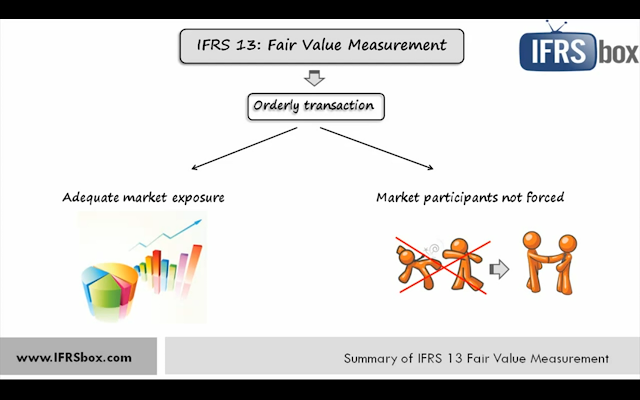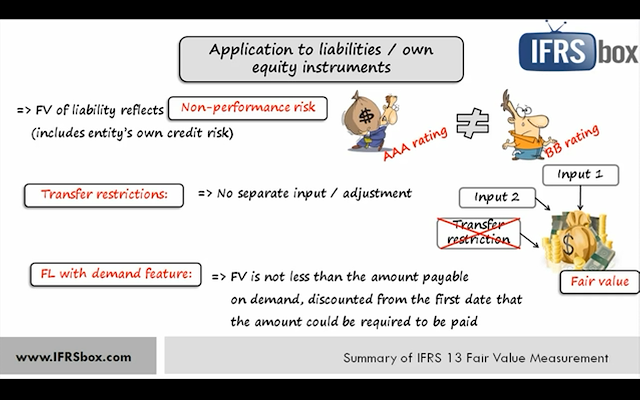Objective
IFRS 13
- - Defines fair value
- - Sets out in a single IFRS a framework for measuring fair value
- - Requires disclosures about fair value measurements.
Except for:
- - Share-based payment transactions within the scope of IFRS 2 Share-based Payment
- - Leasing transactions within the scope of IAS 17 Leases
- - Measurements that have some similarities to fair value but that are not fair value, such as net realisable value in IAS 2 Inventories or value in use in IAS 36 Impairment of Assets.
Term
Fair value | The price that would be received to sell an asset or paid to transfer a liability in an orderly transaction between market participants at the measurement date |
Active market | A market in which transactions for the asset or liability take place with sufficient frequency and volume to provide pricing information on an ongoing basis |
Exit price | The price that would be received to sell an asset or paid to transfer a liability |
Highest and best use | The use of a non-financial asset by market participants that would maximise the value of the asset or the group of assets and liabilities (e.g. a business) within which the asset would be used |
Most advantageous market | The market that maximises the amount that would be received to sell the asset or minimises the amount that would be paid to transfer the liability, after taking into account transaction costs and transport costs |
Principal market | The market with the greatest volume and level of activity for the asset or liability |
Unit of account
Over view market to measure FV
Example of Principal market
Most advantageous market
Market participant
Orderly transaction
Fair value hierarchy
Overview
IFRS 13 seeks to increase consistency and comparability in fair value measurements and related disclosures through a 'fair value hierarchy'. The hierarchy categorises the inputs used in valuation techniques into three levels: (unadjusted) quoted prices in active markets for identical assets or liabilities - observable price of similar in active market - unobservable inputs. [IFRS 13:72]
Level 1 inputs are quoted prices in active markets for identical assets or liabilities that the entity can access at the measurement date. [IFRS 13:76]
A quoted market price in an active market provides the most reliable evidence of fair value and is used without adjustment to measure fair value whenever available, with limited exceptions. [IFRS 13:77]
Level 2 inputs are inputs other than quoted market prices included within Level 1 that are observable for the asset or liability, either directly or indirectly. [IFRS 13:81]
Level 2 inputs include:
- quoted prices for similar assets or liabilities in active markets
- quoted prices for identical or similar assets or liabilities in markets that are not active
- inputs other than quoted prices that are observable for the asset or liability, for example
- interest rates and yield curves observable at commonly quoted intervals
- implied volatilities
- credit spreads
- inputs that are derived principally from or corroborated by observable market data by correlation or other means ('market-corroborated inputs').
Level 3 inputs inputs are unobservable inputs for the asset or liability. [IFRS 13:86]
An entity develops unobservable inputs using the best information available in the circumstances, which might include the entity's own data, taking into account all information about market participant assumptions that is reasonably available. [IFRS 13:87-89]
Measurement of fair value
A fair value measurement requires an entity to determine all of the following: [IFRS 13:B2]
- the particular asset or liability that is the subject of the measurement (consistently with its unit of account)
- for a non-financial asset, the valuation premise that is appropriate for the measurement (consistently with its highest and best use)
- the principal (or most advantageous) market for the asset or liability
- the valuation technique(s) appropriate for the measurement
Non-financial assets


Liabilities and own equity instrument
Guidance on measurement
IFRS 13 provides the guidance on the measurement of fair value, including the following:
- The fair value of a liability reflects non-performance risk (the risk the entity will not fulfil an obligation), including an entity's own credit risk and assuming the same non-performance risk before and after the transfer of the liability [IFRS 13:42]
- An optional exception applies for certain financial assets and financial liabilities with offsetting positions in market risks or counterparty credit risk, provided conditions are met (additional disclosure is required). [IFRS 13:48, IFRS 13:96]
An entity uses valuation techniques appropriate in the circumstances and for which sufficient data are available to measure fair value, maximising the use of relevant observable inputs and minimising the use of unobservable inputs. [IFRS 13:61, IFRS 13:67]
Three widely used valuation techniques are: [IFRS 13:62]
- market approach – uses prices and other relevant information generated by market transactions involving identical or comparable (similar) assets, liabilities, or a group of assets and liabilities (e.g. a business)
- cost approach – reflects the amount that would be required currently to replace the service capacity of an asset (current replacement cost)
- income approach – converts future amounts (cash flows or income and expenses) to a single current (discounted) amount, reflecting current market expectations about those future amounts.
In some cases, a single valuation technique will be appropriate, whereas in others multiple valuation techniques will be appropriate. [IFRS 13:63]
Disclosure
IFRS 13 requires an entity to disclose information that helps users of its financial statements assess both of the following: [IFRS 13:91]
- for assets and liabilities that are measured at fair value on a recurring or non-recurring basis in the statement of financial position after initial recognition, the valuation techniques and inputs used to develop those measurements
- for fair value measurements using significant unobservable inputs (Level 3), the effect of the measurements on profit or loss or other comprehensive income for the period.
The disclosure requirements are not required for: [IFRS 13:7]
- plan assets measured at fair value in accordance with IAS 19 Employee Benefits
- retirement benefit plan investments measured at fair value in accordance with IAS 26 Accounting and Reporting by Retirement Benefit Plans
- assets for which recoverable amount is fair value less costs of disposal in accordance with IAS 36 Impairment of Assets.
Where disclosures are required to be provided for each class of asset or liability, an entity determines appropriate classes on the basis of the nature, characteristics and risks of the asset or liability, and the level of the fair value hierarchy within which the fair value measurement is categorised. [IFRS 13:94]
Some disclosures are differentiated on whether the measurements are:
- Recurring fair value measurements – fair value measurements required or permitted by other IFRSs to be recognised in the statement of financial position at the end of each reporting period
- Non-recurring fair value measurements are fair value measurements that are required or permitted by other IFRSs to be measured in the statement of financial position in particular circumstances.
To meet the disclosure objective, the following minimum disclosures are required for each classof assets and liabilities measured at fair value (including measurements based on fair value within the scope of this IFRS) in the statement of financial position after initial recognition (note these are requirements have been summarised and additional disclosure is required where necessary): - Read detail in [IFRS 13:93]
Quantitative disclosures are required to be presented in a tabular format unless another format is more appropriate. [IFRS 13:99]
Effective date and transition
[IFRS 13:Appendix C]
IFRS 13 is applicable to annual reporting periods beginning on or after 1 January 2013. An entity may apply IFRS 13 to an earlier accounting period, but if doing so it must disclose the fact.
Application is required prospectively as of the beginning of the annual reporting period in which the IFRS is initially applied. Comparative information need not be disclosed for periods before initial application.
By IAS+ and IFRS box














No comments:
Post a Comment